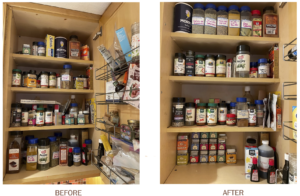
Last week I did a Facebook Live session on how you can learn about Information Architecture and other aspects of User Experience by analyzing the intelligence embedded in the way you organize the spices in your spice cabinet. The goal of this 8-minute talk was to help promote my upcoming class RIVA 221 the Principles of User Experience Research and Testing. Most of the people who take this class are experienced qualitative market researchers who want to learn about User Experience so they can add UX Research to their skill set. I’ve taught at RIVA for over a decade and always look forward to teaching this class. As someone who has worked in User Experience since the early 90s, the key focus of UX seems like common sense (e.g., you identify the target audience(s) for a product or service, then learn about each type of user’s workflow, task flow, and understanding of the particular domain your team is automating, and so on). These foundational aspects are practical vs. academic, and taken together they constitute the user-friendliness of a product or service.
One of these basic concepts is the notion of “Information Architecture”, which is the organization of elements in a system. That organization needs to match the understanding (aka “mental model”) of the people who are using the system. The organization of these elements also needs to align with the tasks these users perform as they interact with the elements. While this might sound pretty abstract to you, it really isn’t when you look at specific examples of Information Architecture in our everyday lives such as book indexes, the Dewey Decimal system in libraries, or how products are organized in a supermarket. These are all well-organized systems that have been time-tested and serve people/users from very broad backgrounds. Each of us who participates in the modern world has internalized the logic of each of these systems and that allows us to efficiently navigate through them to find exactly what we are looking for among thousands, if not millions of choices without having to think too hard.
In most of the classes I teach, whether at RIVA or privately for an organization, I leverage examples from our everyday lives to help students grasp key concepts. This speeds up learning and helps the students feel confident that they’ve developed a solid understanding of what is User Experience before they can do UX Research.
So, what can you learn about Information Architecture by observing how your spice cabinet is organized? Let’s start by looking at mine. In the “Before” example my spices have no specific organization, which makes my cooking task flow more cumbersome and time consuming because I need to rifle through each shelve looking for specific spices needed in the recipe. In the “After” example I’ve organized the spices in several different ways – by bottle size, by manufacturer, by spices that go together (e.g., cloves, nutmeg, and cinnamon are grouped together). The “After” version matches how I think about spices (in a variety of organizational schemes) and how I use them when I cook. Taken together, these organizational schemes make up a custom Information Architecture that works well for me. When I go to cook something, it takes a few seconds for me to find the spices I need because I’ve organized the bottles according to how I use them in a recipe. In UX parlance, the spice cabinet’s “Information Architecture” matches my mental model and task flow. Bingo – success!!
However, suppose I had to share this spice cabinet with housemates who have a different background and orientation towards cooking than me, like a professional chef or someone from a different ethnic background ? A professional chef has a much deeper and detailed understanding of spices because of their education and experience. A person from a very different ethnic background uses spices I am unfamiliar with, creates dishes that seem exotic to me, and likely uses a different cooking workflow. Not only might the organization of my spice cabinet take on political and interpersonal dimensions, but it would be a lot of work to develop a robust Information Architecture that meets all our needs. If we didn’t have time to create one, then we’d likely just organize the spices in a way that everyone understands, e.g., alphabetically.
The focus of a lot of User Experience Research is on identifying who are the target users and what makes each user type (aka persona) unique. Most often it’s the user’s understanding of the space that differentiates one group from another. The source of the differentiation can be the user’s prior experience, their training, culture or other factors. UX Researchers seek to understand these factors and how they contribute to the end user’s mental model of the system. We also spend a good deal of time helping our teams develop organizational schemes that line up think about the system and perform tasks. It takes a good deal of effort, time, trial and error, and skill to get it right. To be successful you really do need to listen deeply to the user so you know how they think, observe them at work, and see the world from their perspective.
